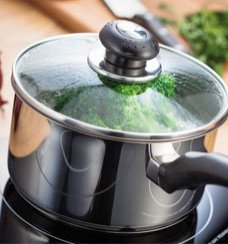|
DIY
Shop Now
|
British Food Fortnight: How To Make Homemade Sausages
When you think of traditional British food, sausages must be close to the top of the list. Good old 'bangers and mash' is a staple meal in homes up and down the country.
And with British Food Fortnight running between 19th September and 4th October, there's no better time to enjoy this Great British classic!
But instead of buying from a supermarket, why not make your own sausages? It might look difficult to master, but with the right equipment, you can easily make your own bangers from the comfort of your kitchen.

Let's try a simple pork sausage recipe...
Sausage making equipment
To make the sausages, there are a few pieces of kit you will need:
-
- A mincer
- A sausage funnel (the mincer above comes with an attachment)
- A large, sturdy mixing bowl
You'll also need some sausage casings – the 'skin' that will keep the meat in shape. Sheep casings are best for thinner sausages, while a hog casing is better if you prefer chunky bangers. A good butcher should be able to provide you with some casings, or you can order online if you're struggling.
There are collagen casings available, but most people prefer the authentic result that a hog casing provides.
For this recipe, which makes around 20 sausages, you'll need approximately 20 feet of casing, which is about 6 metres. It might be best to have more to hand just in case your first attempt goes wrong.
Ingredients
The measurements below will produce about 2.5kg (5lb 7oz) of sausage meat – enough for around 20 links. You can adjust the measurements accordingly to make a smaller or larger batch.
-
- 1.75kg (4lb) pork shoulder
- 500g (1lb 2oz) pork back fat
- 80g (3oz) salt
- 180g (6oz) breadcrumbs
- 2 tbsp cold water
- 2 tsp dried sage
- 1 tsp white pepper
Method
First things first, you need to get the casings ready for use. If you're using hog or sheep casings, these will have been thoroughly cleaned and preserved in salt. To get them ready, you need to soak them in cold water for a few hours – overnight if possible.
When it comes to preparing the ingredients, the key is to keep things cold. In fact, the meat and fat should be thoroughly chilled to make a good sausage. The fat in particular will mince more easily if it's cold; put it in the freezer for an hour or so before you come to mincing. The pork should chill in the fridge.
It will even pay to put your mixing bowl in the freezer for an hour before use – the colder the better!
Now you're prepared, it's time to start making your sausages.
- Chop your meat and fat into chunks, and then chill them for an hour or so.
- Next, mince the meat and fat through the coarse mincing plate onto a large, deep tray. It's best to alternate between chunks of meat and fat.
- Mix the salt, sage, pepper and breadcrumbs together, and sprinkle over the meat and fat.
- Add the water, and then mix together thoroughly.
- Make a small patty from the mixture, and fry it. Try the patty to see if it's to your taste; if it's too bland, you can now add more spices and seasoning to the mixture.
- Put the fine mincing plate onto your mincer, and attach the sausage funnel.
- Slip the casing over the sausage funnel nozzle, tying a knot in the end and leaving around 6 inches of casing hanging off the end (to allow for the air to collect).
- Mince the mixture through the plate into the casing. (You may need someone to help at this stage).
- It might take some practice, but try not to fill the casing too tight as this can cause the case to split or burst. Try also not to let too much air into the casing.
- When you've minced all the meat mixture through into the casing, remove from the funnel and set aside.
- Decide upon a length for your sausages, and with your thumb and finger, squeeze some space at that point, and twist to create a link.
- Do the same with the next link, but twist the casing the opposite way. Repeat all the way up the casing, alternating the direction of the twist each time.
- Tie off the end of the casing, and set aside the sausages.
- Look for any bubbles of air in the sausages, and prick them using a clean cocktail stick.
- Refrigerate the sausages overnight to allow them to plump up.
All done? Now it's time to enjoy your lovely homemade bangers! They should keep in the fridge for up to a week. Any that you don't use can be frozen for three to four months - just remember to defrost them thoroughly before you cook them!
Serving your sausages
The classic way to enjoy a good sausage is to serve with mashed potato and veg.
Grill or shallow fry the sausages until golden and thoroughly cooked. Steam some seasonal vegetables, and serve alongside some creamy mash. Don't forget to drizzle some tasty onion gravy over it all!
If you're looking for another meal to use your sausages in, why not try a hearty full English breakfast at the weekend?
Another great winter warmer is toad in the hole. And perhaps in the summer months you can try them on the barbecue... The possibilities are endless!
Give them another twist
Once you've got the hang of it, you can tweak your recipe to your liking. Add different herbs and spices to the pork, or perhaps use a different meat altogether.
Some interesting sausage variations to try are beef, lamb or venison.
Do you have any sausage recipes or any top tips for sausage making? Let us know in the comments.
And don't forget to let us know how your homemade sausages turn out!



















